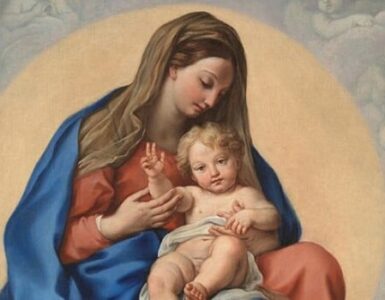In 1215 when Magna Carta was being signed in England, the most successful reforming council for a thousand years was taking place in Italy. It was called the Fourth Lateran Council. St. Dominic, St. Francis of Assisi, St. Bonaventure, St.Thomas Aquinas, and four major new religious orders were involved in spreading the reform all over Christendom. When asked why these new mendicant orders were teaching and preaching outside their monasteries, it was St. Thomas Aquinas who replied simply: their job was firstly to contemplate, and then share the fruits of their contemplation with others (Contemplare et Contemplata aliis Tradere). These words summed up the new reform which St. Francis saw as nothing other than ‘the Gospel of Our Lord Jesus Christ,’ but it also summed up the spirituality of the first Christian communities before monasticism was founded. It was the fruits of this contemplation, the infused virtues, and the gifts of the Holy Spirit that dazzled the ancient pagans with a quality of pure human goodness and loving selflessness that was never seen before.
The Document that Never Was
If the Second Vatican Council had produced a document detailing a modern representation of the ancient God-given spirituality that his Son handed on to his first followers, as it should have done, then its conclusion would have mystified its readers. The measure of the shock and bewilderment that would have reverberated around the Church would be the measure of just how far we have departed from our spiritual origins. Priests and prelates, as well as the laity, would look at one another in disbelief, for the mystical prayer they were told ‘began in mist and ended in schism’ would be back on the agenda. There would have to be an authoritative restoration and reinstatement of mystical theology in all seminaries, houses of religious education, and Catholic universities to teach the profound prayer that enables the Holy Spirit to lead us through meditation to the mystical contemplation of God, in, with and through Christ.
The reason why no such document was written, as I was to discover for myself in the years ahead, was as simple as it was devastating. The great scholastic theologians and the great biblical scholars, the liturgists and moral theologians at the council had, like everyone else, been deprived of the mystical theology that was commonplace before the condemnation of Quietism and its cataclysmic after-effects. Mystical theology had been long since taken off the syllabuses in seminaries and houses of Catholic further education. However, deep renewal will only get underway again when it is reinstated and taught by practitioners.
The Biggest Shock of My Life
When in 1969 Bishop Casey of Brentwood asked me to become the managing director of his retreat and conference center in North London, I asked my old theology teacher to become the principle visiting theology lecturer, a post that he filled until my tenure came to an end in 1981. When after several years I asked him to take on the role of teaching mystical theology I received the biggest shock of my life. He simply said that he knew nothing whatsoever about the subject. My shock was multiplied many times over as I approached other theologians and received the same sort of response. I had to teach the subject myself, for all the theology in the world would quite literally be pointless unless it is underpinned by the Church’s time-honored teaching on how to die to self and carry a daily cross in prayer beyond first beginnings. I immediately began an audit of all the priests and religious who came to the center, only to discover that very few were taught how to pray apart from liturgical prayer, and those who had were never taught anything about mystical prayer.
An Invitation from Rome
When I asked why I was summonsed to Rome at the end of the 1970s to teach Mystical Theology, I was told there was no one else able to do it except from a purely academic and historical point of view. Invitations then came in to speak from all over the world on a subject that since the condemnation of Quietism nobody seemed to know anything about. For many years to come, my initial findings were confirmed over and over again. The enthusiasm of those who, after attending my courses in Rome encouraged their superiors to invite me to speak, was not matched by the vast majority of my audiences. And yet when the terrible cases of sexual abuse by priests and religious hit the headlines everyone was flabbergasted and could not see the reasons why!
If only the meditation that leads to mystical contemplation had been taught in all houses of clerical and religious education, the selfless loving learned in contemplative prayer would have introduced them directly to the love they would otherwise have experienced in the Sacrament of Marriage. We all need to love and be loved. If those who take a vow of chastity are not simultaneously taught how to come to know and experience God’s love, then they could eventually seek counterfeit love elsewhere, sometimes with the disastrous consequences that we have all seen. Unfortunately, the gap created by the demise of true authentic Christian mystical spirituality has been filled by psycho-sexual-anything-goes New Age movements that are to be deplored. However, I do not want to end on a somber note. I have come across many good people who are cooperating with the Holy Spirit and have traveled far and deeply in the spiritual life, but sadly with little help and usually much opposition.
A Christian Shangri-La
At the end of one of my lecture tours in Africa, I was privileged to meet a monk who had reached the pinnacle of the spiritual life. I had hoped to have met Padre Pio, but by the time I was able to arrange a visit to San Giovani Rotundo he had died on September 23rd, 1968. Fr. Gregory was, in my opinion, another living saint. He was a Cistercian monk who was trained at the Trappist monastery of Mount St. Bernard, near Coalville in Leicestershire, England. He and several other monks opened a daughter house at Mbengwe in the republic of the Cameroon many years before. When I was privileged to meet Fr. Gregory who was eighty-five at the time, only he and three others remained from the original group. The Nigerian Abbot presided over a large and spiritually thriving African community that I likened to James Hilton’s book, Shangri-La.
Only You Have Been Keeping Me Out
Fr. Gregory told me he spent thirty years in the Dark Night, in which there were moments when he thought he had lost his faith. Then one day he became ill and was confined to the monastery’s infirmary. From the moment he was laid up in bed he experienced what he called a weak but ongoing ecstasy that he not only experienced in his head but in his whole being. By that he meant that he was at all times lost in God, but at no time did the experience render him unconscious nor less capable, but rather more capable of his work than ever before. Then on three separate occasions just as he was about to receive Holy Communion, he heard these words, “Only you have been keeping me out”. He emphasized that he knew without a doubt that he was listening to the voice of Christ himself. Furthermore, he insisted that the words were not spoken to him in his head, but out loud and in words, “as loud as you are speaking to us in the monastery church.” In those days I had a very powerful voice! It is only we who prevent God’s love from instantly being born again in us as he was born in Mary’s womb.
A Glimpse of Hell on Earth
He told me that he had glimpsed the hell that was in him, and so he knew that this same hell was in everyone else too. From time immemorial human beings have tried to keep the evil that is in us all in check by issuing laws, rules and regulations, with sanctions and penalties for offenders to keep the demons within from bursting out. However, despite the laws, the evil that is within does burst out, not just to commit individual crimes, but national and international atrocities as internecine wars commit unmentionable acts of brutality and barbarism. Only an arrogant fool believes that we can oppose this evil and destroy it ourselves. Endless fascination with the evil in the world and in the Church can become like a pernicious drug addiction that can at best paralyze a person into inert apathy, or at worst can make us porous to evil, possessing us with the stuff that sinners are made of.
The Practice of Acts of Selflessness in Prayer
There is only one power that can destroy this evil at its source within us, and that is the power of infinite love. When we do all in our power to invite infinite love into our hearts, we are doing the most important thing we can do, so that evil may be defeated and good may prevail. But there is hope, and we can do something, precisely because we have been created in the image and likeness of God and yearn to love him and be loved by him. This hope becomes more than a vague longing when we try to do all in our power to strengthen and fortify this primeval longing with the infinite loving unleashed on the first Pentecost. It is this love that continually flows out of the Risen Christ that enables us to generate and practice acts of selflessness in prayer. When through practice, divine and human love combine, it is to produce a new and invincible brand of contemplative loving that cannot be penetrated by evil. It can open up the passageway through which our love can finally enable God’s unalloyed and infinite love to do what is quite impossible without it.
It was from Fr. Gregory that I first heard a monk explain to me how he chose short prayers from the liturgy to support his longing for God when mystical darkness enveloped him. It was in this action, with his attention fixed on God, that divine and human love combined and contemplative loving was generated. He was adamant that this was the practice of countless monks before him, as far back as the Desert Fathers.
I have never forgotten Fr. Gregory because I believe that in meeting him I met the man I am striving to become, at least in some small way—a living embodiment of the man who rose again from the dead on the first Easter day.
David Torkington is the author of Wisdom from the Western Isles and Wisdom from the Christian Mystics which complement this series.
Image courtesy of Pixabay.
This article originally appeared on SpiritualDirection.com and appears here with kind permission.













